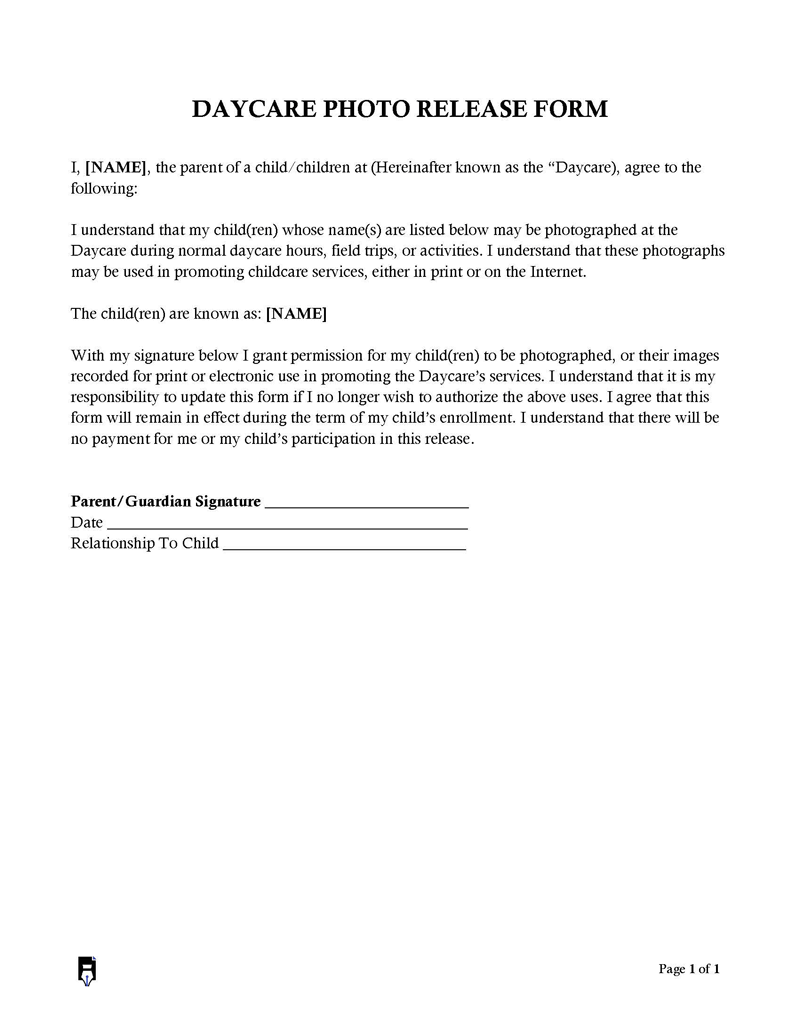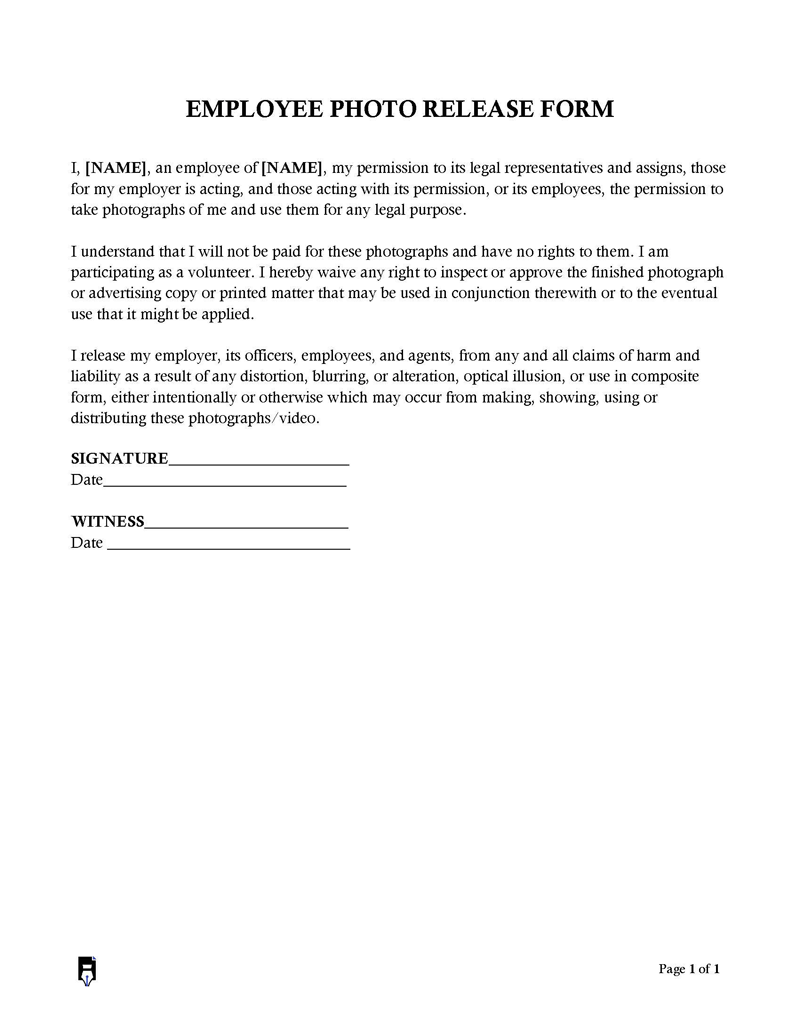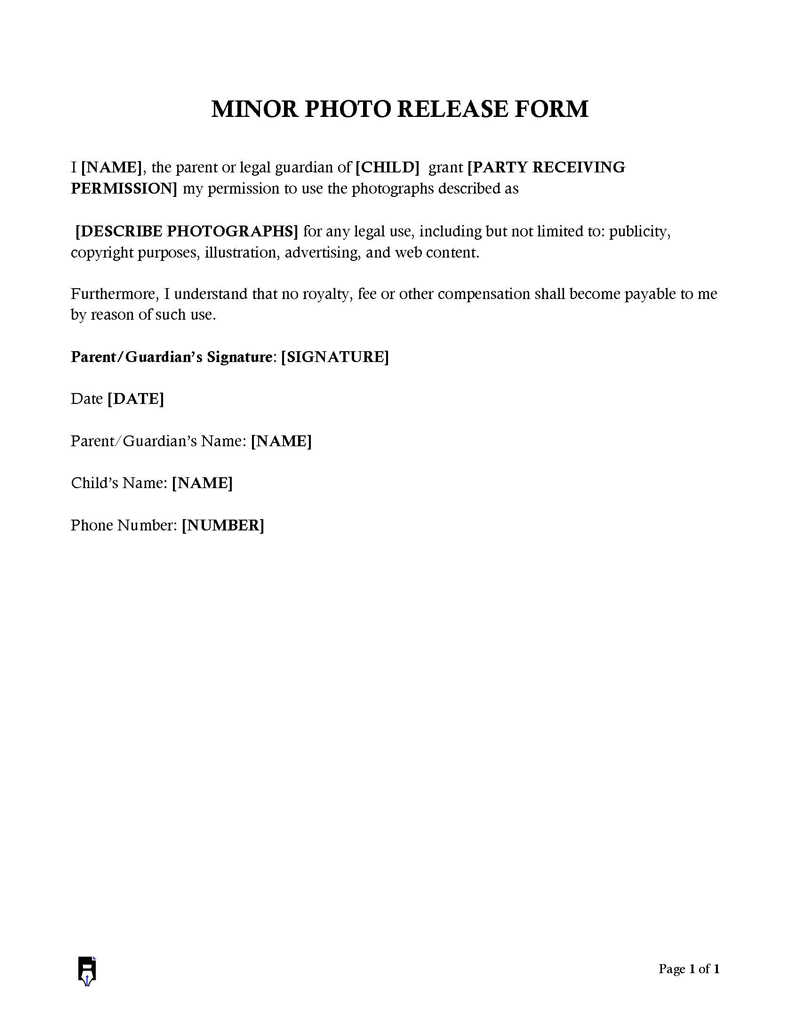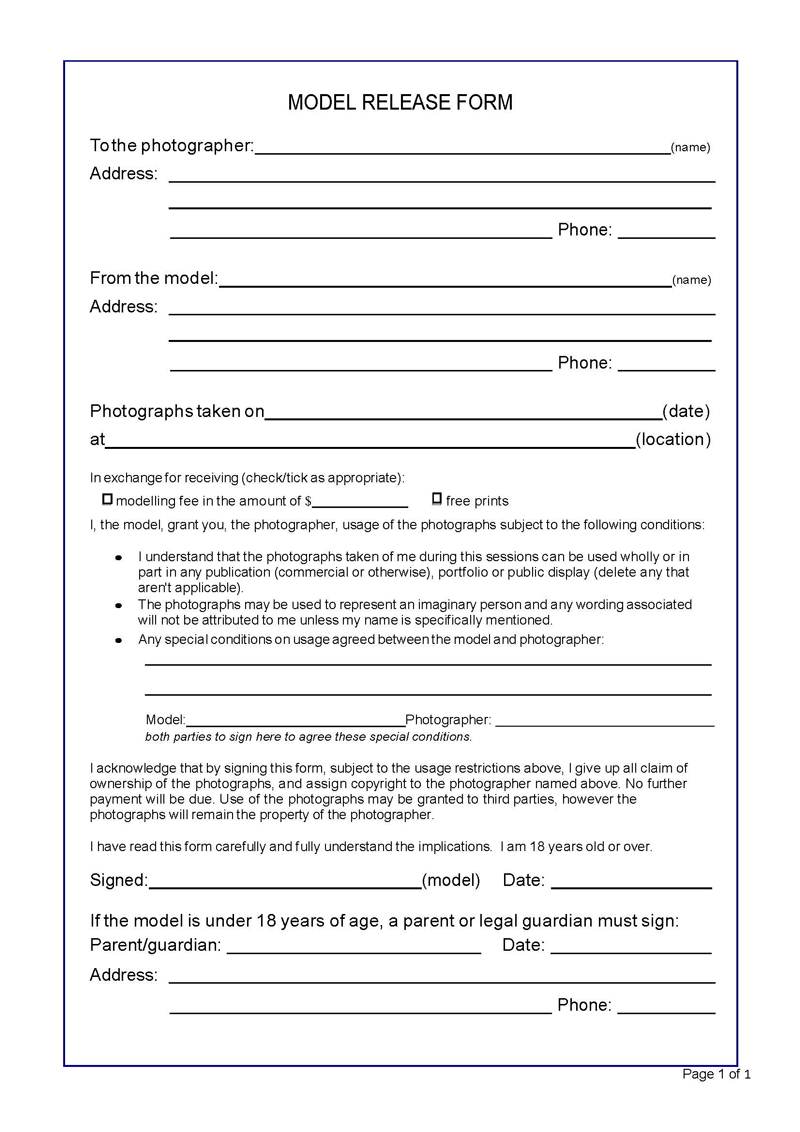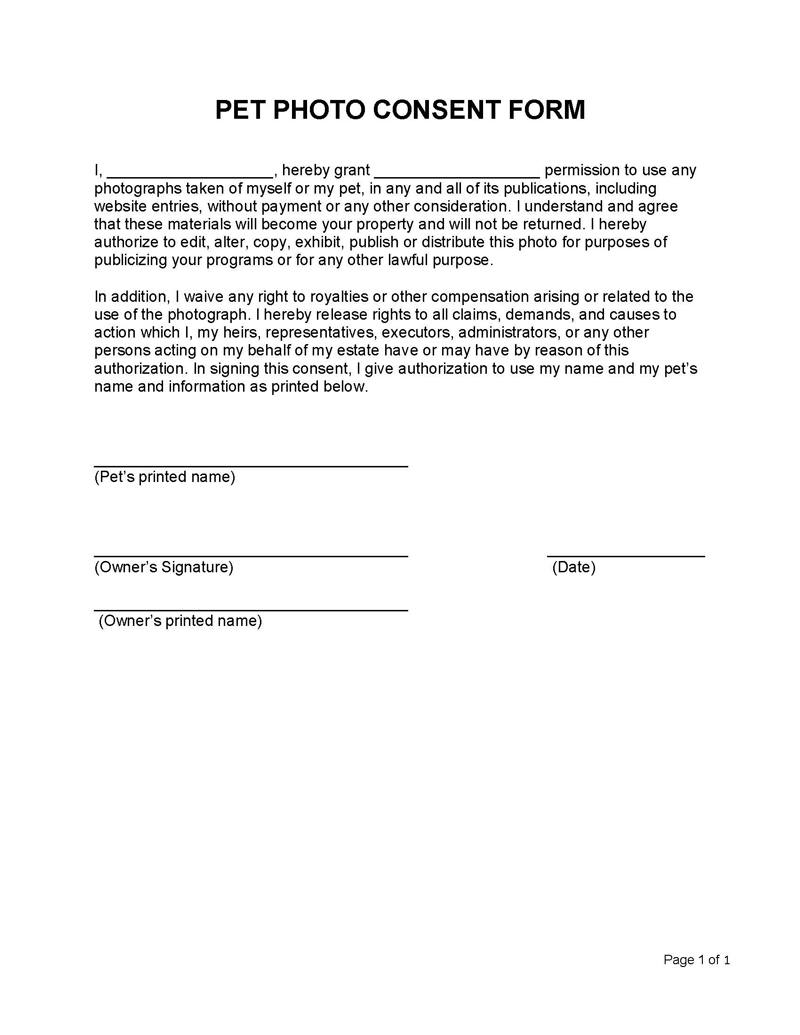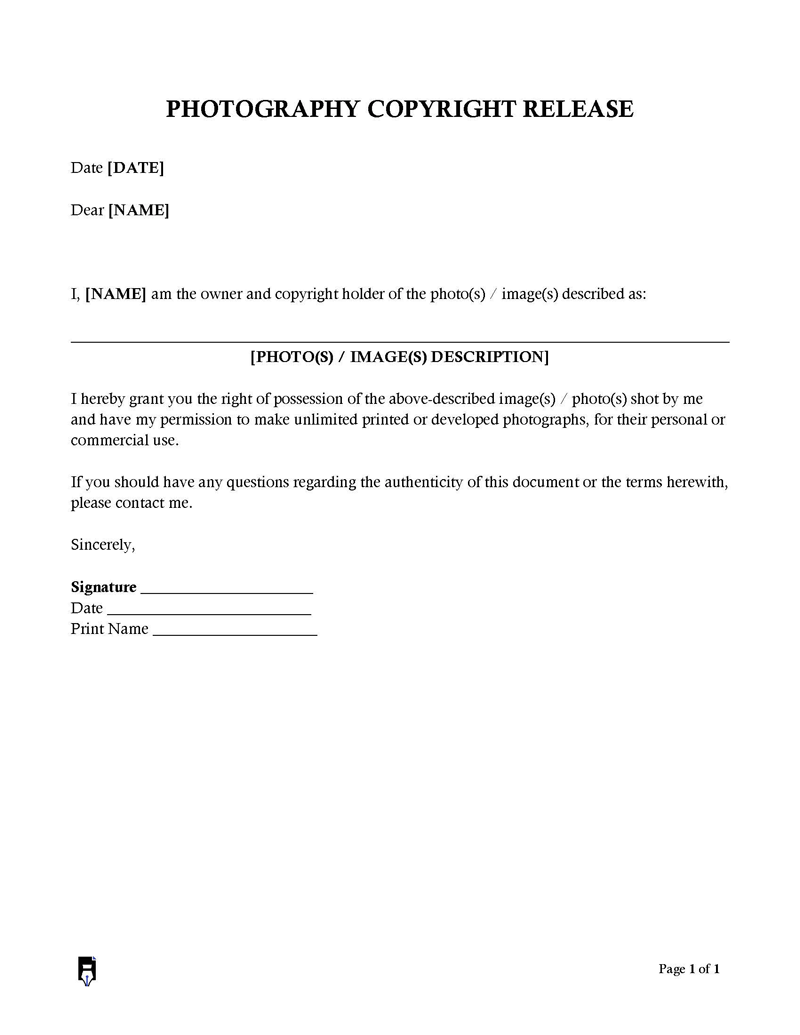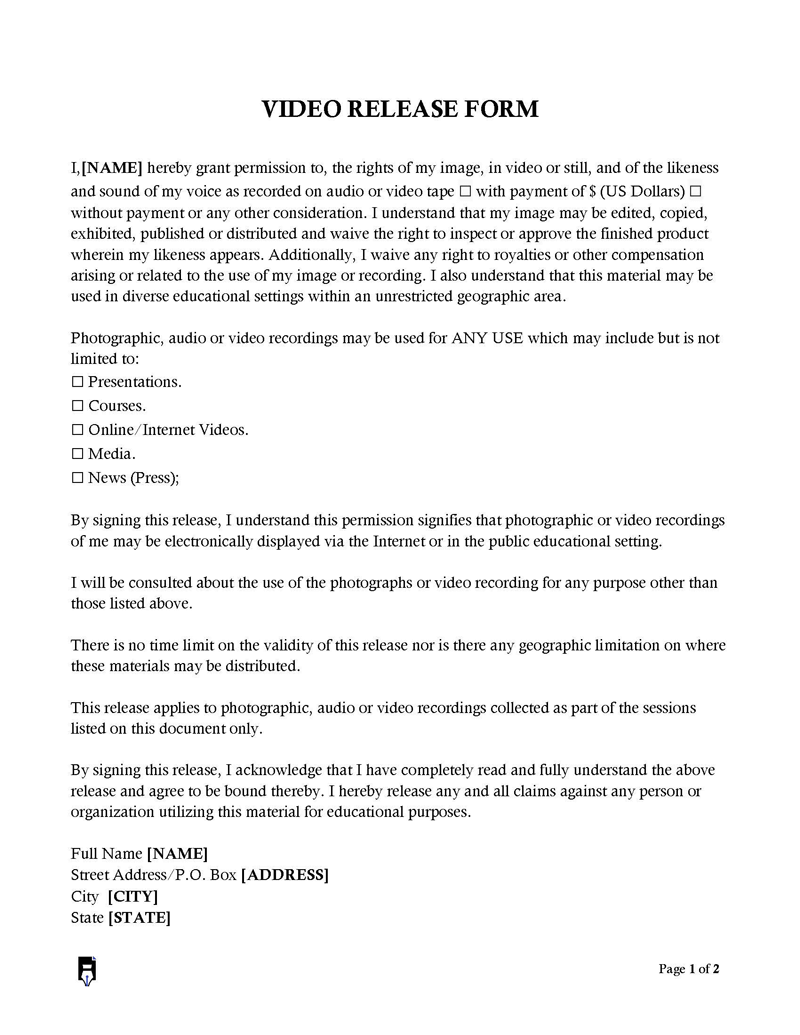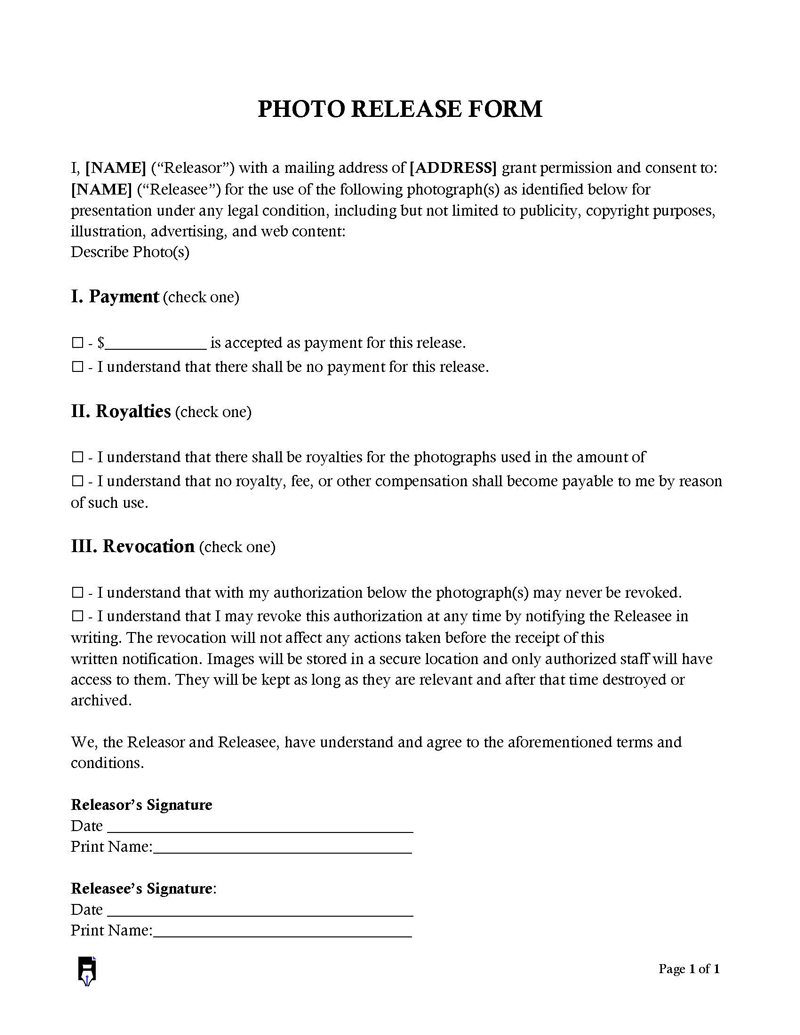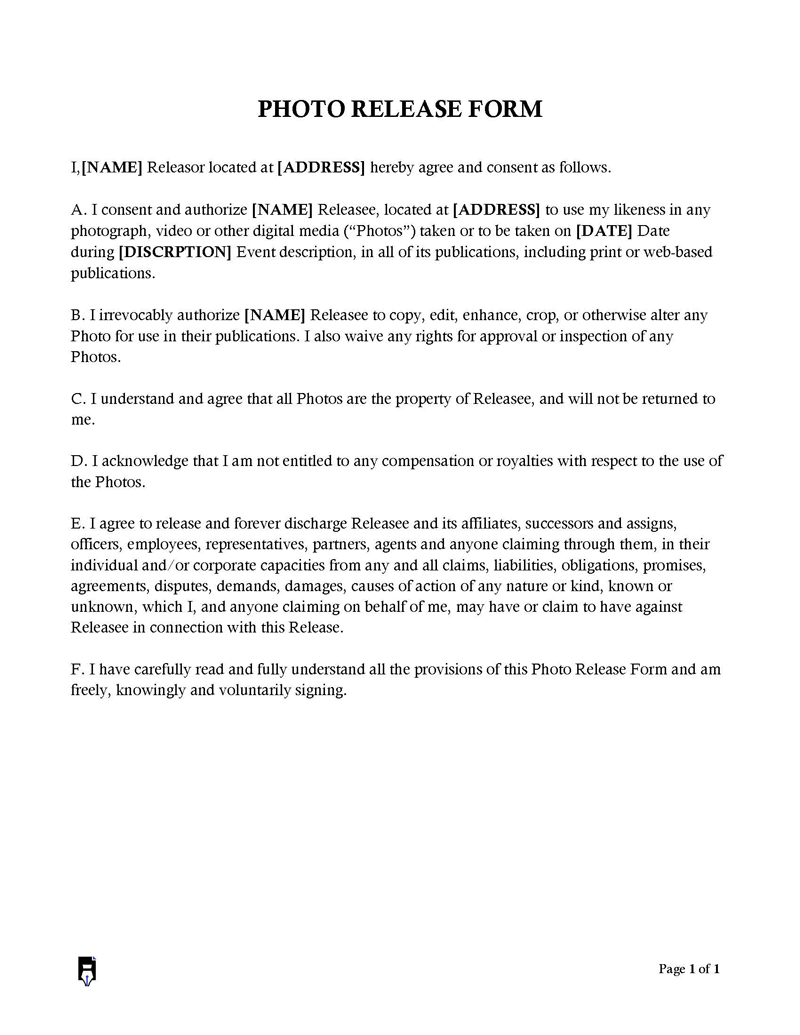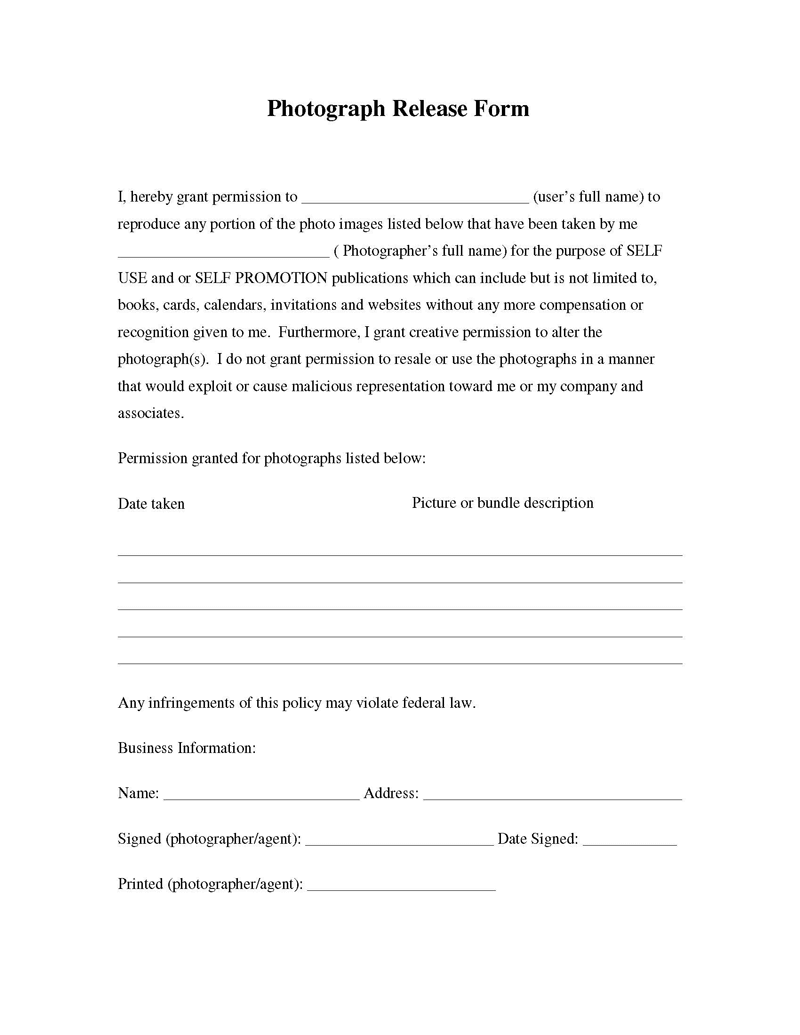A Photo Release Form is a document that gives an individual (usually a photographer) the right to use a photograph of a model for personal or commercial use. The photo release form is typically signed by the party whose image and/or likeness are photographed to grant the photographer consent to use the photograph for commercial or personal uses.
Overview
The party whose image appears in the photograph is referred to as the “releasor,” and they can legally choose to grant the rights to the images for a fee or for free. The fee charged is referred to as “royalty”. If there is a royalty involved in the transfer of the rights of ownership of an image, the transfer is not final until the payment has been made and the photograph release form has been authorized. By signing a photo release form, the releaser relinquishes any claims that they may have regarding the publication and use of the images in question.
A photographer may be able to use a photograph through implied consent. Implied consent only applies if the subject of the photograph is aware that they are being captured and shows no objection. Implied consent offers no protection if the photographer chooses to publish the image.
Alternative names of the photo release form
A photo release form may also be described by a few other names, such as;
- Model Release
- Likeness release form
- Photo copyright release form
- Photo consent form
- Video release form
Need for a Photo Release Form
A photo release form is required when a photograph containing a recognizable image of an individual is to be used commercially. Commercial usage includes receipt of monetary gain as well as publications such as a business card or broker or promotion of goods and services. An individual may be hired as a model by an employer or an independent contractor. In a situation such as this, the independent contractor or employee requires a photo release form to be able to legally distribute and utilize photos of the individual for personal or commercial purposes.
The following situations require a photo release form:
- The photograph is to be used on a website
- The photo is to be used in an ad
- The photo is to be used in a poster
- The photo is to be used in a greeting card
- The photo is to be used as part of a kiosk display
- The photo is to be included in a brochure
- The photo is to be used in digital media
- The photo is to be used as part of a trade show
- The photo is to be sold to an art patron
Types of Photo Release Forms
There are quite a few situations that may necessitate the use of a photo release form. These situations may differ in the circumstances and purpose for which the photograph is taken, or the individual(s) involved. The following are the specific types of photo release forms commonly used;
Daycare Photo Release Form
A daycare photo release form provides consent to a daycare to use photos of a child. Since the subject of the photo is a minor, a daycare photo release form is required to be signed by the parent or legal guardian of the subject.
Employee Photo Release Form
An employee photo release form is used by an employer to obtain consent to use an employee’s image for commercial purposes. An employer may seek consent to use an employee’s image on their about page or the company website as well as for other marketing purposes. The employee in this situation is legally able to provide consent and will be required to sign the photo release form.
Minor (Child) Photo Release Form
A minor (child) photo release form is used to provide consent to a third party by the legal guardians or parents of a child. The third party is given the right to use the images containing the likeness of a child. A minor child photo release form is commonly used for school photos. However, it can also be used for professional purposes as well.
Model Photo Release Form
A model photo release form is needed by a photographer seeking consent from a model to use their photos. A model may also require a model photo release form when seeking consent from the photographer to use the photo. In a situation like this, the model has the right over his or her image. However, the photograph remains the creative property of the photographer. Hence, they also have a right over the photo.
Pet Photo Release Form
A pet photo release form is required when the subject of the photograph is a pet. The owner of the pet is required to sign the pet photo release form, granting the third party the right to use the images of the pet.
Photography Copyright Release Form
A photography copyright release form is signed to allow the trademark or copyright images or letters to be removed from any photographs captured by the photographer. Since the trademark and copyright are properties of a legal entity, the photography copyright release form allows the trademark or copyright to be removed from the photos relieving the photographer of any legal liability.
Video Release Form
A video release form is signed to allow a third party to legally use any video footage of the releasor for commercial or personal use. The releaser should appear in the video footage to necessitate a video release form.
When to Use a Photo Release Form
The following situations necessitate the use of a photo release form. For each situation, the table below specifies the releasee as well as the releasor.
| Releasee | Releasor |
|---|---|
| Event organizer | Event participant |
| Sports team | Sports fan |
| School or university | Student |
| Skydiving company | Skydiver |
| Gala host | Gala Attendee |
| Concert organizer | Concert Attendee |
| Photographer | Model |
Crafting a Photo Release Form
To be able to use a photo of another party, either for commercial or personal use, a photo release form must be crafted by the releasee.
When crafting a photo release form, the releasee should consider the following:
- How the releasee intends to use the photographs.
- When the photo release form is being signed.
- Where the photos are to be taken.
- The compensation (if any) involved.
- Who grants permission to use their photos?
The releasee may follow the steps below to craft a photo release form:
Names of the entities
The first thing to include in a photo release form is the name of the entities concerned. The entities may be a group of people, individual, or an organization. The entities should be named as the legal entities concerned, either as an organization or institution.
Name of photographer or releasee
The photographer or releasee should also be specified by name. The releasee may also be an employer or independent contractor. Specifying the releasee defines the photo release form to legally bind the releasor and the releasee.
Name of model or releasor
The person whose image or likeness is the subject of the photo must be named. Specifying the name of the model whose image is the subject of the photo also serves to name the model as the releasor.
Address and phone number
The address and phone number of the releasor must be specified to further identify the releasor.
Description of specified photographs
A detailed and concise description of the specific photographs for which the releasor is signing a photo release form should be written in the photo release form.
Longevity of the validity of the form
As with most legal forms, the longevity of the validity of a photo release form must be specified. If the photo release form grants the releasee rights over the photographs in question indefinitely, it should be specified in the photo release form.
Details of permissions being granted
The photo release form must contain the details of the usage the releasor is consenting to. This protects the releasor from any legal liability should the release choose to use the photo for criminal activity.
Address payments and royalties
In a situation where the releasor grants consent to the release to use their photo at a price, the agreed-upon payments, royalty amounts and terms must be specified in the photo release form.
Conditions of participation
There are certain conditions under which the releasee may involve the photo of the releasor in any activity. The conditions under which a releasor agrees for their image to participate in any of the releasee’s activities should be specified in the photo release form.
Ability to revoke authorization
The releasor may choose to revoke the authorization provided by the photo release form in certain situations. The conditions that invalidate the consent of the photo release form must be specified in the form.
Verification statement
It is important to include a verification statement that verifies all information provided in the photo release form. Both the releasor and releasee are required to verify all the information provided in the photo release form.
Additional provisions
All additional provisions must be stated and specified in the photo release form. These include the following:
- Claims: The releasor can specify any legal claims they still choose to retain with their photograph in the photo release form.
- Governing law: The governing law under which the photo release form is signed should be cited in accordance with the immediate locality or jurisdiction under which the photo was taken.
- Modifications: If the provisions in the photo release form require modification, the conditions that necessitate such modifications should be stated in the original photo release form.
- Parent or guardian signature: If the photo release form is signed on behalf of a minor, the parent or guardian’s signature must be included in the photo release form.
- Severable: The condition under which the terms stated in the photo release form may be severed must also be specified in the photo release form.
Signatures, Names, and Address
The photo release form is not valid until the signatures, names, and addresses have been specified and attached. Both the releasor and the releasee are required to attach their names, addresses, and signature to the photo release form.
Date of the release
The date on which the photo release form was signed must be specified. This gives the rights of the releasee a definite start date.
Free Photo Release Form Templates
Consequences of not Using a Photo Release Form
When a photograph is taken without obtaining consent via a photo release form, there are certain consequences. The photographer may suffer some limitations in the use of the photo or risk a lawsuit for improper use of another party’s image. The following are the most common consequences of not using a photo release form.
Lost time
When a photographer, employee, or independent contractor does not use a photo release form, the subject of the photograph may choose to pursue a legal alternative for their compensation. The legal case will likely be a lengthy one that will take up a significant amount of time for both the releasor and releasee.
Lost money
The legal proceeding for seeking compensation as well as for defending against such a suit requires a considerable amount of money for legal fees as well as loss of income as a result of the time spent in court. Both the releasor and the releasee will suffer a considerable loss financially when a photo release form is not used.
Mental anguish
The time spent in court, as well as the legal implications of using a party’s likeness without their consent, will constitute considerable mental anguish for the releasee should they neglect to use a photo release form.
Legal Rules for Photography
The general rule for a photographer taking photos can be broken down into a single sentence: Photos taken in public spaces are allowed, while private properties require permission. This sentence is of course an oversimplification of the legal regulations governing photographers. However, that is the basis for the rules.
Get permission in case of any doubt
While the physical position of the photographer when the photos are taken primarily determines whether or not the photographer requires permission from a property owner, it is advisable for the photographer not to simply rely on their physical position. The photographer should try to obtain permission from the property owner even if they may not need it. By simply obtaining permission from the property owner.
Exceptions to the general legal rule
As with most rules, the general legal rule for photography also has some exceptions. A military installation may choose to prohibit photographs in a bid to protect national security. Nuclear facilities may also adopt this rule, in which case a photographer may not be allowed to take photographs. These facilities may have public access areas where photographs are allowed.
Photographing in public places
Photographers are most commonly confronted when taking photos of people in public places. The general legal rule remains for a photographer to take a photo of people in a public area such as a park. If the subject is in a public area but takes the initiative to distance themselves from other people in the same area, it is implied that the subject has a reasonable expectation of privacy, the photographer should therefore respect this expectation.
As long as the photographer is in a public place, the photographer usually has legal permission to take a photograph of the following;
- Accidents.
- Children.
- Rescues.
- Bridges.
- Celebrities.
- Commercial buildings.
- Infrastructures.
- Industrial facilities.
- Residential units.
- Transportation facilities.
- Public utilities.
- Criminal acts.
- Superfund location.
- Law enforcement.
- Arrests.
Dealing with questions
As a photographer has the right to take photographs in a public area, all the people in the public area also have the right to approach the photographer and enquire as to what they are doing. It is in the photographer’s best interest to hold a civil conversation with curious members of society in order to continue to take photos while reassuring other people within the area.
Detainment
A private citizen has a very limited ability to detain the photographer. In the event that a photographer is detained against their will, the photographer has grounds to press for criminal or civil charges.
Law enforcement and photographer’s equipment
If a photographer is taking photos of an occurrence in a public area, an accident, or a fire incident, for instance, a law enforcement agent has no right to seize the photographer’s equipment, nor do they have any right to demand to review the images the photographer has taken without a warrant.
Legal remedies
If a photographer is harassed for taking photographs, the photographer may be able to press civil or criminal charges against the other party. The court may choose to punish the other party in some way if they are found guilty of the charge pressed against them by the photographer. This is referred to as a legal remedy.
Dealing with confrontation
One of the best and most effective methods of dealing with confrontation is to be progressive and stop it before it begins. A photographer may prevent a confrontation by simply providing short, courteous answers that will help people around them understand that they have the right to take photos and that their actions have no malicious intent.
Photographers in Uk
Whether the photographer is taking photos using a camera or a cell phone, they have the right to take photos in public places. A photographer taking photos in public places in the United Kingdom should know the following in order to protect their rights.
Photographing people
When a photographer is in a public area such as a footpath or highway, they can take photos for both personal and commercial purposes. However, the photographer may not obstruct others or violate any anti-terrorism laws in the course of their photography. In addition, a photographer must not violate the Official Secrets Act.
Photographing places
Areas that fall on the spectrum of a public area can be photographed without any legal issues; however, the photographer should take note that they are not allowed to take a photo of Parliament squares, the royal parks, or Trafalgar Square.
Trespassing or obstruction
It is a criminal offense for a photographer to obstruct the free passage of other people on bypass footpaths, highways, or other public areas. Doing this may attract a criminal charge. It is therefore important that the photographer ensures that when in a public area, other people can easily move around them.
Deleting photos
Photographer is entitled to protect their photos, and security officers may not delete images from a photographer’s camera. It is not uncommon for police officers to attempt to remove a memory card from a photographer’s camera. However, these officers have no right to delete a photographer’s photos.
Anti-terrorism in the UK
Due to a rise in terrorist activities worldwide, photographers are often confronted while taking photos of landmarks and monuments, power stations, and bridges. During such a confrontation, a law enforcement agent may attempt to cite the official secrets act or the terrorism act of 2000.
Copyright law
The most important thing a photographer should note about copyright law is that the best way to verify whether or not a photographer’s rights were violated is to consult with an attorney who specializes in intellectual property rights.
Digital Millennium copyright act (DCMA)
The digital Millennium copyright act (DCMA) is somewhat of a complex matter. A photographer can learn about their rights as a photographer by speaking with an attorney who specializes in intellectual property, which includes trademarks and copyrights.
FAQs
How do I create a photo release form?
You can create a photo release form by downloading our well-written photo release form templates. By reading the guide above, you can get all the information you need to create and fill the photo release form and guide the clients or releasor to sign the photo release form.
Why do you need a photo release form?
Photographers, employers, and independent contractors need a photo release form if they intend to use a client or employee’s photo for commercial purposes. Using a photo release form protects the employer, independent contractor, or photographer from legal liability or lawsuits.
Can a photographer use photos without a release?
A photographer is not legally allowed to use a photograph without a release. If a photographer uses a photo without a release, regardless of if the photographer gains financially, the releasor may choose to pursue legal restitution via a lawsuit.
Do photographers own the rights to their photos?
When a photographer takes a photograph, the photograph remains their creative intellectual property to which they own the rights. A photographer, however, does not own the rights to a photograph taken under the employment of another individual. When a photographer is hired as an independent contractor and paid to take photos, the photographer still owns the rights to the photos.
